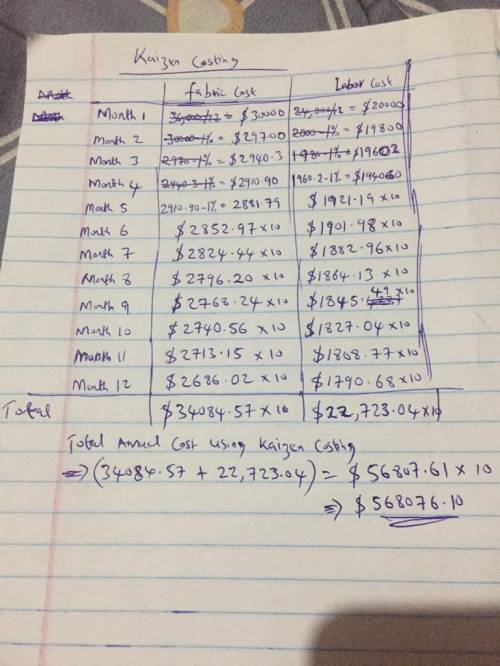
Business, 19.03.2021 18:50 anaalashay
US Apparel (USA) manufactures plain white and solid-colored T-shirts. Budgeted inputs include the following
Price Quantity Cost per unit of output
fabric $8 per yard 0.75 yards per unit $6 per unit
labor $16 per DMLH 0.25 DMLH per unit $4 per unit
dye $0.50 per ounce 4 ounces per unit $2 per unit
For colored T-shirts only
Budgeted sales and selling price per unit is as follow:s:
Budgeted Sales Selling Price per Unit
White T-shirts 10,000 units $12 per T-shirt
Colored T-shirts 50,000 units $15 per T-shirt
The USA has the opportunity to switch from using the dye it currently uses to using an environmentally friendly dye that costs $1.25 per ounce. The company would still need 4 ounces of dye per shirt. The USA is reluctant to change because of the increase in costs (and decrease in profit), but the Environmental Protection Agency has threatened to fine the company $130,000 if it continues to use the harmful but less expensive dye
a. Given the preceding information, would the USA be better off financially by switching to the environmentally friendly dye? (Assume all other costs would remain the same.)
b. Assume the USA chooses to be environmentally responsible regardless of cost, and it switches to the new dye. The production manager suggests trying Kaizen costing. If the USA can reduce fabric and labor costs each by 1% per month on all the shirts it manufactures, by how much will overall costs decrease at the end of 12 months? (Round to the nearest dollar for calculating cost reductions.)
c. Refer to requirement 2. How could the reduction in material and labor costs be accomplished? Are there any problems with this plan?.

Answers: 3


Other questions on the subject: Business

Business, 21.06.2019 21:30, tonta22
Recently, verizon wireless ran a pricing trial in order to estimate the elasticity of demand for its services. the manager selected three states that were representative of its entire service area and increased prices by 5 percent to customers in those areas. one week later, the number of customers enrolled in verizon's cellular plans declined 4 percent in those states, while enrollments in states where prices were not increased remained flat. the manager used this information to estimate the own-price elasticity of demand and, based on her findings, immediately increased prices in all market areas by 5 percent in an attempt to boost the company's 2016 annual revenues. one year later, the manager was perplexed because verizon's 2016 annual revenues were 10 percent lower than those in 2015"the price increase apparently led to a reduction in the company's revenues. did the manager make an error? yes - the one-week measures show demand is inelastic, so a price increase will decrease revenues. yes - the one-week measures show demand is elastic, so a price increase will reduce revenues. yes - cell phone elasticity is likely much larger in the long-run than the short-run. no - the cell phone market must have changed between 2011 and 2012 for this price increase to lower revenues.
Answers: 3

Business, 22.06.2019 12:00, bbyniah123
Select the correct answer. martha is a healer, a healthcare provider, and an experienced nurse. she wants to share her daily experiences, as well as her 12 years of work knowledge, with people who may be interested in health and healing. which mode of internet communication can martha use? a. wiki b. email c. message board d. chat e. blog
Answers: 2

Business, 22.06.2019 17:00, Ididntwanttomakethis
Aaron corporation, which has only one product, has provided the following data concerning its most recent month of operations: selling price $ 102 units in beginning inventory 0 units produced 4,900 units sold 4,260 units in ending inventory 640 variable costs per unit: direct materials $ 20 direct labor $ 41 variable manufacturing overhead $ 5 variable selling and administrative expense $ 4 fixed costs: fixed manufacturing overhead $ 64,200 fixed selling and administrative expense $ 2,900 the total contribution margin for the month under variable costing is:
Answers: 2

Business, 22.06.2019 21:10, winterblanco
The blumer company entered into the following transactions during 2012: 1. the company was started with $22,000 of common stock issued to investors for cash. 2. on july 1, the company purchased land that cost $15,500 cash. 3. there were $700 of supplies purchased on account. 4. sales on account amounted to $9,500. 5. cash collections of receivables were $5,500. 6. on october 1, 2012, the company paid $3,600 in advance for a 12-month insurance policy that became effective on october 1. 7. supplies on hand as of december 31, 2010 amounted to $225. the amount of cash flow from investing activities would be:
Answers: 2
You know the right answer?
US Apparel (USA) manufactures plain white and solid-colored T-shirts. Budgeted inputs include the fo...
Questions in other subjects:


History, 21.04.2020 20:57

Social Studies, 21.04.2020 20:57



Mathematics, 21.04.2020 20:57







